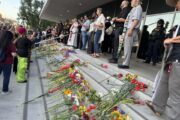This post originally appeared at Religion Dispatches.
the cluster of comment on the recently released report on the changing American religious landscape from the Pew Research Center, we have seen two basic story lines: the U.S. is “less Christian” now than it was seven years ago—by about 8 percent, and the population of “nones” has increased, from 16 percent in 2007 to 23 percent this time around.
As bad as those numbers may sound for religious groups, things are actually even worse. The report only shows how many people consider themselves Catholic, Jewish, Baptist or “nothing in particular.” What this leaves out (which I suspect will be detailed in future reports) is what these religious identities mean as measured by attendance at services or participation in religious community.
In other words, do people who say they are Baptist or Catholic actually attend services and participate in the life of any faith community? Is religion really a part of their everyday lives, or is it just an identity marker?
We know from other research that attendance at religious services has been declining for decades, most noticeably in mainline Protestant and Catholic churches and Jewish synagogues. Now even groups like evangelicals are beginning to see their numbers thin out. Worse, younger people, who represent the future of religious groups, are attending services less often than are older generations. For example, current data on 23-28 year-olds shows that whether they claim a religious identity of not, 52 percent never attend religious services and are otherwise uninvolved in a religious congregation.
Taking into account both increased disaffiliation and decreased attendance at religious services means that the actual decline of religiosity is greater that what the Pew numbers tell us.
This may be bad or good news, depending on your perspective. Surprisingly, some religious leaders are trying to spin it in a positive direction. Southern Baptist leader Russell Moore said that the evangelical herd is essentially culling itself of “pretend Christians,” who are simply being more honest about their (lack of) beliefs. This is the same sentiment I’ve heard mainline denominational and congregational leaders express, when I’ve asked about their decline and what the future might hold.
The implication is that these churches will be stronger going forward with fewer members. I can’t decide if these leaders are delusional or just unduly optimistic about the future of their religious organizations.
On the other hand, things may not be as bad as they appear. Buried in the Pew report are responses from those who said that they have “no religion in particular” to the question, “How important is religion in your life – very important, somewhat important, not too important, or not at all important?” Forty percent responded that religion is “very” or “somewhat” important in their lives. This might come as a surprise to pundits and scholars who assume the religiously unaffiliated don’t believe in God or are somehow “secular.”
The data—including what is available through the Pew report— shows that disbelief in God is relatively stable across time and generation. Indeed the current report shows that atheists (3%) and agnostics (4%) still comprise a relatively small proportion of the American population. Thus, the increase in religious disaffiliation is not necessarily linked to an increase in disbelief per se.
Rather, the phenomenon of the religious “nones” represents the larger reality that increasing numbers of Americans are disenchanted with and disengaged from big institutions in general, whether political, financial, government or religious. That is, unless those institutions directly benefit them. To the extent that churches represent large and often out-of-touch institutions that seem more interested in keeping themselves in business than in serving the needs and desires of members and (potential) attendees, people will continue to opt out of them.
From my vantage point, the current disarray in American religious identity and participation is less a story of people “losing their religion” than one of dissatisfaction with the institutional options available to them.
What does this mean for the future of American Christianity?
The decline of mainline Protestants and Catholics is unlikely to reverse. Younger generations may be marginally interested in the “smells and bells,” but they are allergic to the large-scale institutions that demand not only spiritual allegiance but also financial commitment. Crumbling bell towers require incessant appeals for money. None of those things are “religion” for these people. And now, the franchised megachurch model also is beginning to lose its appeal for younger people. They don’t want to simply reproduce a model that somebody else created.
But contrary to the doomsday headlines, all is not necessarily lost for churches. In work I am currently engaged in, my colleagues and I are finding that the corporate, megachurch-dominated models of organizing religious and spiritual activity are starting to be replaced by smaller, more locally oriented church communities, and by larger churches that attract the masses for a spiritual or musical performance, and a sense of belonging to something much larger than themselves.
Young people are looking for intimacy and personal connections, deep spiritual experiences, service to others and the opportunity to create their own community, whether religious or not.
Religion is not going anywhere anytime soon, regardless how people may identify themselves. But business as usual among existing religious institutions will not stem the losses we are seeing.
Photo Credit: SGT Pablo Piedra, U.S. Army on Flickr
Richard Flory is the executive director of the USC Center for Religion and Civic Culture.








